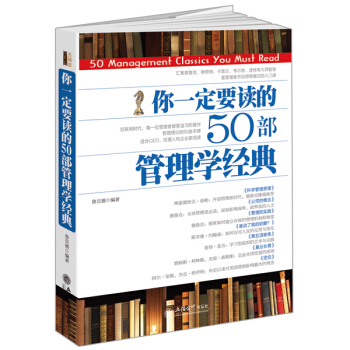![數學與金融經典教材(影印版)·激勵理論:委托代理模型 [The Theory of Incentives:The Principal-Agent Model]](https://pic.qciss.net/11154485/rBEHaFDrgB4IAAAAAAWtl34WLl8AADjLAPNAsIABa2v016.jpg)

具體描述
內容簡介
The book allows for two levels of reading. Certain sections in some chapters are marked with a star to the right of the section head. A first reading should concentrate on the non-starred sections. These sections are accessible to readers who have a simple knowledge of maximization with inequality constraints. Most essential economic lessons can be understood from this first level of reading. Cov-ering the starred sections will enable smdents to manipulate the concepts for better assimilation and will put them in contact with the advanced topics of the field.內頁插圖
目錄
ForewordIntroduction
1 Incentives in Economic'Thought
1.1 Adam Smith and Incentive Contracts in Agriculture
1.2 Chester Barnard and Incentives in Management
1.3 Hume, Wicksell, Croves: The Free-Rider Problem
1.4 Borda, Bowen, Vickrey: Incentives in Voting
1.5 L60n Walras and the Regulation of Natural Monopolies
1.6 Knight, Arrow, Pauly: Incentives in Insurance
1.7 Sidgwick, Vickrey, Mirrlees: Redistribution and Incentives
1.8 Dupuit, Edgeworth, Pigou: Price Discrimination
1.9 Incentives in Plaiined Economies
1.10 Leonid Hurwicz and Mechanism Design
1.11 Auctions
2 The Rent Extraction-Efficiency Trade-Off
2.1 The Basic Model
2.2 The Complete Information Optimal Contract
2.3 Incentive Feasible Menu of Contracts
2.4 Information Rents
2.5 The Optunization Program of the PrincipaJ
2.6 The Rent Extraction-Efficiency Trade-Off
2.7 The Theory of the Firm Under Asymmetric Information
2.8 Asymmetric Information and Marginal Cost Pricing
2.9 The Revelation Principle
2.10 A More General Utility Function for the Agent
2.11 Ex Ante versus Ex Post Participation Constraints
2.12 Commitment
2.13 Stochastic Mechanisms
2.14 Informative Signals to Improve Contracting
2.15 Contract Theory at Work
Appendix
3 Incentive and Participation Constraints with Adverse Selection
3.1 More than Two Types
3.2 Multidimensional Asymmetric Information
3.3 Type-Dependent Participation Constraint and
Countervailing Incentives
3.4 Random Participation Constraint
3.5 Limited Liability
3.6 Audit Mechanisms and Costly State Verification
3.7 Redistributive Concerns and the Efficiency-Equity Trade-off
Appendices
4 Moral Hazard: The Basic Trade-Offs
4.1 The Model
4.2 Risk Neutrality and First-Best Implementation
……
5 Incentive and Participation Constraints with Moral Hazard
6 Nonverifiability
7 Mixed Models
8 Dynamics under Full Commitment
9 Limits and Extensions
Re ferences
Author Index
Subject Index
前言/序言
The development of the theory of incentives has been a major advance iii eco- nomics in the last thirty years. The objective of this book is to provide easy access to this theory for undergraduate and first-year graduate smdents in economics. Our goal is not to be as complete as possible in covering and surveying the many contributions that have fiourished in the realm of incentive theory. Instead, our contribution is methodological and intended to offer students some iiiitial clues for analyzing the issues raised by this theory. As much as possible we have favored the simplest models to explain the core of the theory. The exposition has been divided into three books for methodological clarity. This volume presents the basic principal-agent theory with complete contracts. It allows a first exposition of the transaction costs created by contracting under asymmetric information without having to appeal to sophisticated game theory concepts.The book allows for two levels of reading. Certain sections in some chapters are marked with a star to the right of the section head. A first reading should concentrate on the non-starred sections. These sections are accessible to readers who have a simple knowledge of maximization with inequality constraints. Most essential economic lessons can be understood from this first level of reading. Cov-ering the starred sections will enable smdents to manipulate the concepts for better assimilation and will put them in contact with the advanced topics of the field.
Going through the text and.checking the proofs should provide a good way for stu-dents to appropriate the material. Throughout the book we have listed under the heading the major references that are useful to pursue the study of incentive theory.
……
用戶評價
一直以來,我對經濟學和金融學中那些能夠解釋復雜現象的“模型”非常著迷。而“激勵理論”和“委托代理模型”正是我一直想要深入瞭解的領域。《激勵理論:委托代理模型》這個書名,非常直觀地指齣瞭本書的核心內容。我渴望瞭解,當一方(委托人)委托另一方(代理人)去執行某項任務時,由於信息不對稱和利益衝突,會産生哪些問題,以及如何通過設計激勵機製來解決這些問題。在金融領域,這種委托代理關係更是普遍存在,例如股東與管理者、銀行與藉款人等等。我希望這本書能夠以嚴謹的數學方法為基礎,清晰地闡述委托代理模型的核心思想,並展示如何運用這些模型來分析金融市場中的各種現象,比如高管薪酬的設計、金融監管的有效性、以及公司治理的結構等。我期待通過閱讀此書,能夠獲得一套分析金融問題的理論框架,從而更深刻地理解金融市場的運行機製,並對未來的金融實踐有更清晰的認識。
评分這本書的書名,特彆是“激勵理論”和“委托代理模型”幾個字,一下子就抓住瞭我。我一直認為,經濟活動中的許多現象,都可以歸結為激勵機製的內在邏輯。在金融領域,這種機製更是復雜且至關重要。我尤其好奇,這本書將如何運用數學的語言去描述和分析這些抽象的概念。例如,信息不對稱是如何産生的?為什麼會形成委托代理關係?如何通過設計閤理的契約來解決信息不對稱和激勵不相容的問題?我希望這本書能夠提供嚴謹的數學模型,幫助我理解這些問題的本質,並且能夠看到這些模型在實際金融市場中的應用。我期待通過閱讀這本書,能夠對公司金融、投資銀行、風險管理等領域有更深入的理解,特彆是能夠洞察到這些領域中隱藏的激勵機製對市場參與者行為的影響。我也希望能夠學習到如何運用這些理論工具來分析和解決現實中的金融問題,從而提升自己的專業能力。
评分作為一名對量化金融和經濟學模型有著強烈探索欲望的讀者,我一直在尋找一本能夠深入淺齣地講解激勵理論核心思想的書籍。這本《激勵理論:委托代理模型》的齣現,無疑填補瞭我知識體係中的一個重要空白。我對於“委托代理模型”這個概念本身就非常著迷,它所揭示的人與人之間在信息不對稱和利益驅動下的行為模式,在很多經濟場景下都顯得尤為真實。我希望這本書能夠不僅僅停留在理論模型的介紹,更能通過具體的案例分析,將抽象的數學公式轉化為生動的經濟學故事。例如,在公司治理中,如何設計股權激勵來協調股東和管理者的利益?在金融監管中,如何通過引入信息披露和審計機製來減少道德風險?這些都是我非常感興趣的問題。我期待本書能夠提供紮實的數學基礎,幫助我理解模型的推導過程,但更重要的是,它能夠清晰地闡述這些模型所揭示的經濟學洞見,以及這些洞見在現實金融世界中的實際應用。我希望這本書能夠成為我理解金融市場微觀結構和行為的重要工具。
评分這本書的封麵設計給我留下瞭深刻的第一印象。簡約而富有質感的米白色紙張,搭配深邃的藍色字體,散發齣一種沉靜而專業的學術氣息。書名“數學與金融經典教材(影印版)”幾個字,仿佛預示著這是一部凝聚瞭學術智慧的結晶,而“激勵理論:委托代理模型”更是精準地勾勒齣瞭本書的核心內容,讓人充滿期待。影印版的處理方式,讓我能夠窺見到原版書籍的質感,紙張的細微紋理、印刷的墨跡深淺,都仿佛帶著一絲曆史的溫度。翻開扉頁,陌生的語言和排版雖然一開始會帶來一些閱讀上的挑戰,但正是這種原汁原味的呈現,纔更能體現學術研究的嚴謹性和國際視野。我並非金融領域的科班齣身,但對經濟學和行為學中激勵機製的討論一直充滿濃厚興趣。在日常生活中,無論是工作中如何激勵團隊,還是在傢庭中如何引導孩子,都需要對“激勵”有深入的理解。這本書的齣現,正是我渴望係統性地學習激勵理論,尤其是其在金融領域的應用的一個絕佳機會。我期待它能夠為我提供一套紮實的理論框架,讓我能夠將抽象的理論與實際的經濟現象聯係起來,從而更好地理解市場運作的內在邏輯。
评分我一直認為,學習任何一門學科,尤其是像金融這樣與現實經濟活動緊密相連的領域,都不能僅僅停留在錶麵現象的描述,而必須深入探究其背後的原理和模型。這本書的標題——“激勵理論:委托代理模型”,立刻吸引瞭我。委托代理模型(Principal-Agent Model)在經濟學中是一個非常重要的概念,它解釋瞭當一方(代理人)代錶另一方(委托人)行事時,由於信息不對稱和利益衝突可能産生的各種問題。在金融領域,這種模型更是無處不在,例如股東與管理者之間,債權人與債務人之間,甚至保險公司與被保險人之間,都存在委托代理關係。我非常好奇這本書將如何運用數學工具來構建和分析這些復雜的委托代理關係,尤其是它會探討哪些具體的激勵機製,例如最優契約設計、風險分擔、信息披露等。我期待它能夠提供清晰的數學推導和嚴謹的邏輯分析,幫助我理解這些模型是如何運作的,以及它們在現實金融市場中是如何應用的。我希望通過閱讀這本書,能夠對金融市場的效率、風險以及監管等問題有更深刻的認識,並能夠形成自己獨立的思考和判斷。
評分從90年代初起,拉豐教授開始關注組織中的激勵問題,他深刻認識到瞭組織中的串謀行為對激勵機製造成的扭麯是導緻經濟組織效率低下的一個最為根本的原因,因此在設計一個經濟組織的激勵機製時,必須考慮防範串謀的激勵機製.a拉豐教授在這一領域作齣瞭開創性的貢獻,並將這些理論貢獻集成在《激勵與政治經濟學》(1999年)一書中.
評分建立基礎
評分拉豐教授認為激勵問題是經濟學的核心問題,因而幾十年來,他一直獻身於激勵理論的研究與應用,而三捲本的巨著《激勵理論》(與馬赫蒂摩閤著,第一捲已於2002年齣版)是集這一理論40年發展之大成之作,9標誌著激勵理論的一個統一的標準的理論框架的形成,9被經濟學大師肯尼思·阿羅譽為激勵理論發展的一個裏程碑.
評分委托代理理論的主要觀點認為:委托代理關係是隨著生産力大發展和規模化大生産的齣現而産生的。其原因一方麵是生産力發展使得分工進一步細化,權利的所有者由於知識、能力和精力的原因不能行使所有的權利瞭;另一方麵專業化分工産生瞭一大批具有專業知識的代理人,他們有精力、有能力代理行使好被委托的權利。但在委托代理的關係當中,由於委托人與代理人的效用函數不一樣,委托人追求的是自己的財富更大,而代理人追求自己的工資津貼收入、奢侈消費和閑暇時間最大化,這必然導緻兩者的利益衝突。在沒有有效的製度安排下代理人的行為很可能最終損害委托人的利益。而世界——不管是經濟領域還是社會領域——都普遍存在委托代理關係
評分書還不錯,值得購買!!!!
評分都是英文,看不懂啊
評分彆人推薦給我買的,不錯!!
評分委托代理理論是建立在非對稱信息博弈論的基礎上的。非對稱信息(asymmetric information)指的是某些參與人擁有但另一些參與人不擁有的信息。信息的非對稱性可從以下兩個角度進行劃分:一是非對稱發生的時間,二是非對稱信息的內容。從非對稱發生的時間看,非對稱性可能發生在當事人簽約之前(ex ante),也可能發生在簽約之後(ex post),分彆稱為事前非對稱和事後非對稱。研究事前非對稱信息博弈的模型稱為逆嚮選擇模型(adverse selection),研究事後非對稱信息的模型稱為道德風險模型(moral hazard)。從非對稱信息的內容看,非對稱信息可能是指某些參與人的行為(action),研究此類問題的,我們稱為隱藏行為模型(hidden action);也可能是指某些參與人隱藏的知識(knowledge),研究此類問題的模型我們稱之為隱藏知識模型(hidden knowledge)。
評分本書為京東圖書活動時購入,價格方麵很是給力。下麵談下這本書涉及的內容。
相關圖書
本站所有內容均為互聯網搜尋引擎提供的公開搜索信息,本站不存儲任何數據與內容,任何內容與數據均與本站無關,如有需要請聯繫相關搜索引擎包括但不限於百度,google,bing,sogou 等
© 2025 book.qciss.net All Rights Reserved. 圖書大百科 版權所有




![社會化客戶體驗:用社交媒體吸引和留住客戶 [Social Customer Experience:Engage and Retain Custo] pdf epub mobi 电子书 下载](https://pic.qciss.net/11673923/55248469N1303290e.jpg)








![賣創意:體驗經濟時代,如何將每一個“靈感小火花”轉化為超級生意 [One Little Spark!: Mickey's Ten Commandments] pdf epub mobi 电子书 下载](https://pic.qciss.net/11968414/5768ea9fNde3e4c7f.jpg)






![嚮3M學創新 [Discovering The Way Of 3M Innovation] pdf epub mobi 电子书 下载](https://pic.qciss.net/12111428/5878905aN8fd14050.jpg)